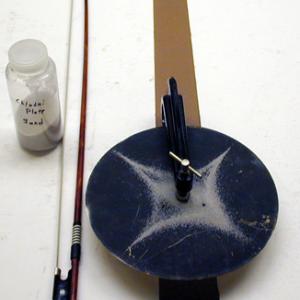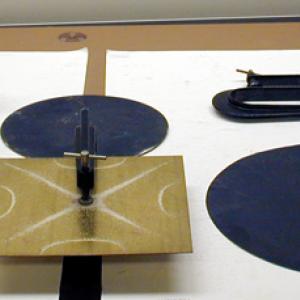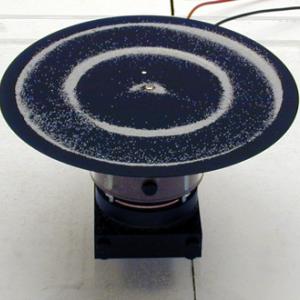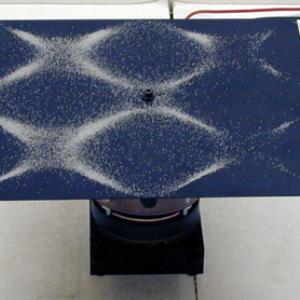College of Liberal Arts & Sciences
3D40.30 - Chladni Plates
Video Credit: Jonathan M. Sullivan-Wood.
PRACTICE WILL BE REQUIRED FOR THIS DEMONSTRATION.
Clamp the plates to the table with the 'S' clamps. Sprinkle some of the fine sand or beads onto the plate. Bow the edge of the plate and watch the patterns that emerge.
Forced nodes can be produced by attaching a neodymium pair of magnets to the top and bottom of the plates.
With the mechanical oscillator this demo becomes very easy to do. The frequencies between 600 and 800 Hz. (700 Hz. is very good) will produce a number of patterns. Since the oscillator is nothing more than a very heavy duty speaker without a speaker cone it will produce a sizable amount of noise when the plates are resonating. The cover off the mousetrap demo will quiet this dramatically but will cut visibility. The oscillator will need to be run at 3/4 to 1 amp to make this work.
DO NOT RUN OVER 1 AMP - hence the amp meter. The oscillator has an upper limit amperage of l amp!!!
A variation is to use brightly colored sand. You could also use sand that has been mixed with some finely ground Tide or other "whitening" laundry powder. Mix some sand in a 5:1 ratio with the laundry powder and you will have sand that will fluoresce under a black light.
- Chris Chiaverina, "Performing Acoustic Experiments Using Inexpensive Bluetooth Speakers and Smartphone Signal Generator Applications", TPT, Vol. 60, #2, Feb. 2022, p. 152.
- Adolf Cortel, "Nodes and Antinodes in Two-Color Chladni Figures", TPT, Vol. 59, #6, Sept. 2021, p. 462.
- Dina Sinclair, Mark Vondracek, "Standing Waves and Inquiry Using Water Droplets", TPT, Vol. 53, #1, Jan. 2015, p. 29.
- John Daffron, "Photo of the Month", TPT, Vol. 50, #6, Sept. 2012, p. 362.
- Randy Worland, "Chladni Patterns on Drumheads: A 'Physics of Music' Experiment", TPT, Vol. 49, #1, Jan. 2011, p. 24.
- Wilfried Sommer, Ralf Meier-Boke, and Nicholas Meinzer, "Hydromonochord: Visualizing String Vibration by Water Swirls", TPT, Vol. 48, #6, Sept. 2010, p. 370.
- LaDawn Haws, "Resonating Blow-Pipe Drum", TPT, Vol. 39, #3, Mar. 2001, p. 176.
- John M. Pitre, "Chladni Plates: How Big Can They Be?", TPT, Vol. 34, #8, Nov. 1996, p. 508.
- John J. DiElsi, "Impedance Matching with Speakers", TPT, Vol. 30, #9, Dec. 1992, p. 516.
- Richard Crane, "Never Throw a 2-inch Speaker Away: It Has Many Uses", TPT, Vol. 30, #6, Sept. 1992, p. 375.
- Thomas B. Greenslade, Jr., "Hopkins' Divided Tube", TPT, Vol. 17, #2. Feb. 1979, p. 113.
- Robert H. Johns, "Bow for Vibrating Plates", TPT, Vol. 12, #8, Nov. 1974, p. 500.
- R. C. Nicklin, "Colorful Chladni", TPT, Vol. 11, #5, May 1973, p. 312.
- Thomas B. Greenslade, Jr., "Hopkins' Divided Tube", AJP, Vol. 73, #7, July 2005, p. 586.
- Thomas D. Rossing, "Comment on 'Chlandi Plates Revisited' by J. R. Cromer, M. J. Shepard, P. N. Henriksen, R. D. Ramsier", AJP, Vol. 73, #3, Mar. 2005, p. 283.
- J. R. Cromer, M. J. Shepard, P. N. Henriksen, R. D. Ramsier, "Chlandi Plates Revisited", AJP, Vol. 72, #10, Oct. 2004, p. 1345.
- B. M. Deutsch, A. R. Robinson, R. J. Felce, and T. R. Moore, "Nondegenerate Normal-Mode Doublets in Vibrating Flat Circular Plates", AJP, Vol. 72, #2, Feb. 2004, p. 220.
- P. J. Ouseph, "Chladni Plates for Overhead Projectors", AJP, Vol. 59, #7, July 1991, p. 665.
- Thomas D. Rossing, "Chladni's Law for Vibrating Plates", AJP, Vol. 50, #3, Mar. 1982, p. 271.
- Allan D. Kautz, "Experiment on the Vibration of a Plate", AJP, Vol. 48, #5, May 1980, p. 358.
- Sb-1, 3: Freier and Anderson, A Demonstration Handbook for Physics.
- W-165: "Chladni Plates", DICK and RAE Physics Demo Notebook.
- 50 Fun Experiments for the Mad Scientist in You, "Dancing Oobleck", National Geographic Kids, p. 90.
- George M. Hopkins', "Chladni's Figures", Experimental Science. Volume Two, p. 137.
- R. W. Pohl, "10. Proper Vibrations of Surfaces and of Solid Bodies. Thermal Vibrations", Physical Principles of Mechanics and Acoustics, p. 252.
- Carson I. A. Ritchie, "Chladni's Figures", Making Scientific Toys, p. 65.
- Jearl Walker, "2.141, Powder Patterns", The Flying Circus of Physics Ed. 2, p. 141.
- Jearl Walker, "1.7, Chladni Figures", The Flying Circus of Physics with Answers.
- Charles Taylor, "3.6.3:" The Art and Science of Lecture Demonstration, p. 122 - 125.
- Carleen Maley Hutchins, "Plate Tuning for the Violin Maker", Catgut Acoustical Society (CAS) Newsletter, #39, May, 1983.
- Raymond Bruman, "Bells", Exploratorium Cookbook I, p. 64.1 - 64.3.
- S-137, 138: Richard Manliffe Sutton, Demonstration Experiments in Physics.
- Neil A. Downie, "Coffee-Cup Revolution Counter", Ink Sandwiches, Electric Worms and 37 Other Experiments for Saturday Science, p. 185.
- This Month in Physics History, "July 8, 1680: The First Experiments that Inspired 18th Century 'Chladni Figures'", APS News, Vol. 26, #7, July 2017, p. 2, 3.
- Joseph Frick, "#137 - Nodal Points on Surfaces. Sound Figures.", Physical Technics: Or, Practical Instructions for Making Experiments in Physics and the Construction of Physical Apparatus with the Most Limited Means", p. 165.
- The Queen Catalogues Vol. II, Catalogue of Physicsal Instruments, No. 4710 - Bench, p. 49.
Disclaimer: These demonstrations are provided only for illustrative use by persons affiliated with The University of Iowa and only under the direction of a trained instructor or physicist. The University of Iowa is not responsible for demonstrations performed by those using their own equipment or who choose to use this reference material for their own purpose. The demonstrations included here are within the public domain and can be found in materials contained in libraries, bookstores, and through electronic sources. Performing all or any portion of any of these demonstrations, with or without revisions not depicted here entails inherent risks. These risks include, without limitation, bodily injury (and possibly death), including risks to health that may be temporary or permanent and that may exacerbate a pre-existing medical condition; and property loss or damage. Anyone performing any part of these demonstrations, even with revisions, knowingly and voluntarily assumes all risks associated with them.




